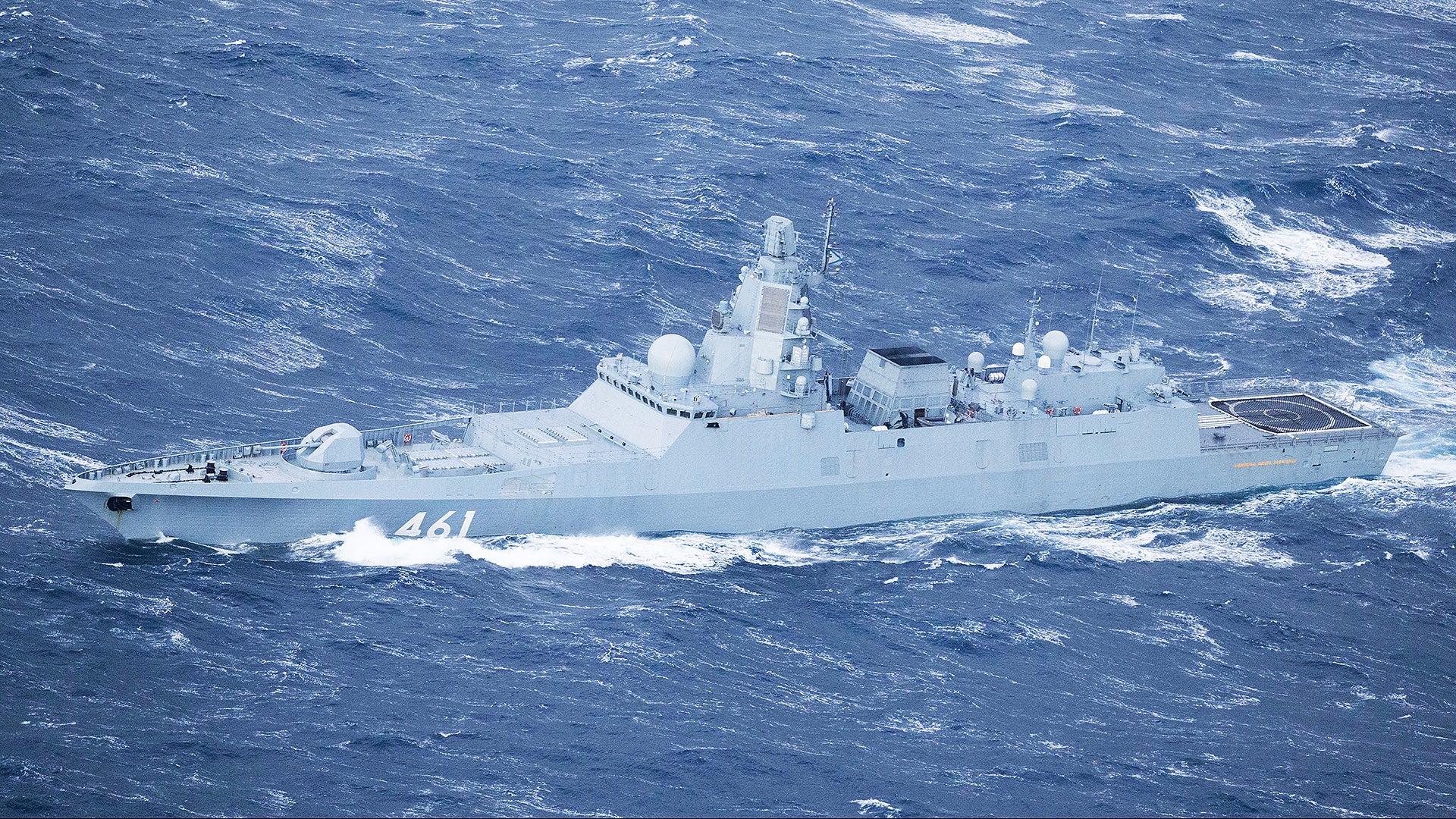A group of Russian Navy warships from that service’s Northern Fleet is poised to enter the English Channel, ahead of their planned participation in a controversial series of live-fire drills scheduled off the southwest coast of Ireland. The vessels, centered around three warships, will not be the first from the Russian Navy to pass through the Channel in recent weeks, having been preceded by the six amphibious warfare ships that left the Baltic Sea last month before entering the Mediterranean Sea, as well as a pair of Steregushchiy class corvettes from the Baltic Fleet that apparently entered the Atlantic via the Channel today.
Publicly available maritime tracking data shows the position of one of the Northern Fleet support vessels in the latest flotilla, the ship in question being the replenishment oiler Vyazma, which has its Automatic Identification System (AIS) transponder on and, as of today, was underway in the North Sea, off the east coast of England, apparently preparing to enter the Channel.

The Vyazma is understood to be accompanied by three surface combatants, the Slava class cruiser
Marshal Ustinov, the Udaloy class destroyer Vice-Admiral Kulakov, and the Admiral Gorshkov class frigate
Admiral Kastanov. Two other support vessels are in the group, as well, the replenishment oiler Kama and the rescue tug SB-406. Unconfirmed reports suggest that a nuclear-powered submarine is also part of the group.


The Northern Fleet flotilla had previously entered the Barents Sea on January 22 and was met the following day off the coast of Finnmark by the Norwegian Coast Guard offshore patrol vessel Andenes. From here, the flotilla made only slow progress, hampered by poor weather, with storms and high waves, and then entered the Norwegian Sea on January 25. While transiting between the Barents Sea and the Norwegian Sea, the flotilla was shadowed by a Royal Norwegian Air Force P-3C Orion maritime patrol aircraft, which took the following photographs, and the photo at the top of this story.
Responsibility for tracking flotilla was then apparently passed on to Denmark, which sent the Iver Huitfeldt class frigate HDMS Peter Willemoes, currently part of NATO Standing Maritime Group 1, to shadow the Russian vessels. At one stage, based on maritime tracking data, it appeared that the Danish warship was effectively in the path of the Russian flotilla. However, it should be noted that the accuracy of this kind of publicly available data can be imprecise, meaning it’s possible that the NATO and Russian vessels remained at a safe distance from each other throughout. As far as is known, neither side made any formal complaint about the activities of the other.
The final destination of the flotilla is understood to be in the Irish Economic Exclusion Zone (EEZ) around 150 miles off the southwest coast of that country, but outside Ireland’s territorial waters. Here, a live-fire exercise is planned to take place between February 5 and 8. These exercises have been variously described as artillery firing drills or ‘rocket firing,’ although Russian officials have not confirmed whether or not missiles will be launched.
These drills are part of a much larger series of exercises that the Russian Navy is planning, with the involvement of all four fleets, and approximately 140 surface combatants and supply ships.
While there is nothing to suggest these exercises are tied in any way to a potential new Russian military intervention in Ukraine, as has been widely feared in the last few months, there is concern that at least some of the vessels involved in European portions of the drill could ultimately be headed to the Black Sea, which would put them in an ideal position to support a possible move against Ukraine.
This is especially the case for the six amphibious warfare ships that are now underway in the Mediterranean, having also transited via the English Channel. Previously, three of these vessels had been the cause of some alarm in the Baltic, resulting in Sweden bolstering its troop numbers and armor on the strategically important island of Gotland. Again, there is no firm evidence that these ships are headed for the Black Sea, although it’s clear that they could play a significant role in a potential amphibious operation against objectives in the south of Ukraine.
As for the Northern Fleet flotilla now expected to pass through the Channel, these could eventually head further south and end up in the Mediterranean, too.
In the meantime, Irish and Russian officials have delivered a succession of statements relating to the upcoming live-fire drills.
In a briefing to the press, Russia’s Ambassador to Ireland, Yury Filatov, stated that there is “no grounds for concern” and dismissed media attention about the maneuvers as part of an “ongoing propaganda campaign by the US and its NATO allies” directed against Russia.
“This is not in any way a threat to Ireland or anybody else. No harm is intended, no problem is expected,” Filatov said.
Meanwhile, Ireland’s Minister for Foreign Affairs Simon Coveney said the Russian drills were “not welcome.”
At one point, Irish fishermen had said they planned to peacefully disrupt the Russian Navy war games, which will be taking place in lucrative fishing grounds, using a fleet of up to 60 trawlers. Now, after talks held in Dublin, a buffer zone will be used for the firing campaign, ensuring a distance of 37 to 49 miles is maintained between Russian and Irish vessels. This still needs to be signed off by the Russian government, however.
Video of a previous Northern Fleet live-fire exercise, dating from 2017:

Once again, it should be stated that there is presently no direct link between the various Russian Navy exercises that are starting in different waters around the world, although the current East-West tensions surrounding Ukraine mean it’s hardly surprising that these large-scale maneuvers are gaining additional interest. After all, should Moscow finally make a move against Ukraine, it’s likely at least some of the warships now being put through their paces in Europe would be involved.
Contact the author: thomas@thedrive.com
